Physical Address
304 North Cardinal St.
Dorchester Center, MA 02124
Physical Address
304 North Cardinal St.
Dorchester Center, MA 02124
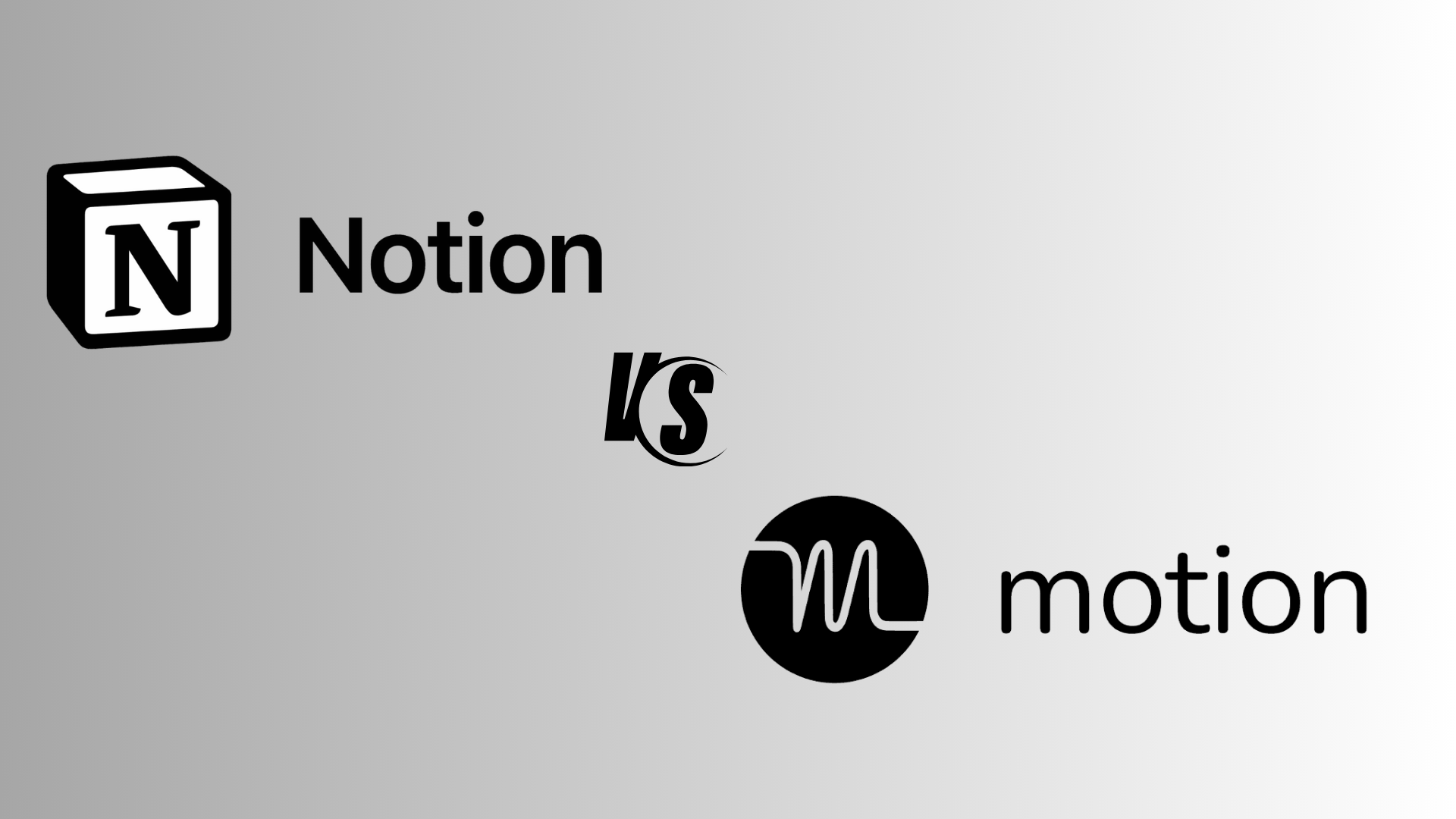

At first glance, one might expect Notion and Motion to be very similar tools, especially considering the resemblance in their names.
However, they are two different platforms, considering what they specialize in.
Motion is an AI-driven project management and smart scheduling assistant. On the other hand, Notion excels in knowledge management, note-taking, and collaboration.
Unlike Motion, Notion requires a more manual approach to task management and organization.
So, when we are comparing these two, the comparison should most likely be named “AI task manager vs Knowledge management tool.”
In our article on “Motion vs Notion,” we’ll discuss how they are different and their core features, along with their pros and cons so that you can decide which one suits you the most.
To make a good comparison, let’s take a quick overview of each tool:
Motion is a project and task management application that syncs with your calendar automatically prioritizes tasks, and assigns time for them. It is architected as a smart assistant for your day and, therefore, an ideal choice for those users who want a tool that fuses task management with scheduling.
Capterra rating: 4.3
g2 rating: 4
The alternative, Notion, is more of a working environment that excels in note-taking, knowledge management, and teamwork. It’s very flexible, and you can build your own workflow with databases, wikis, and to-do lists, which makes it a perfect fit for teams who want a bit of structure but also mobility.
Capterra rating: 4.7
g2 rating: 4.7
Now that we’ve explained what they are, let’s see their benefits and drawbacks.
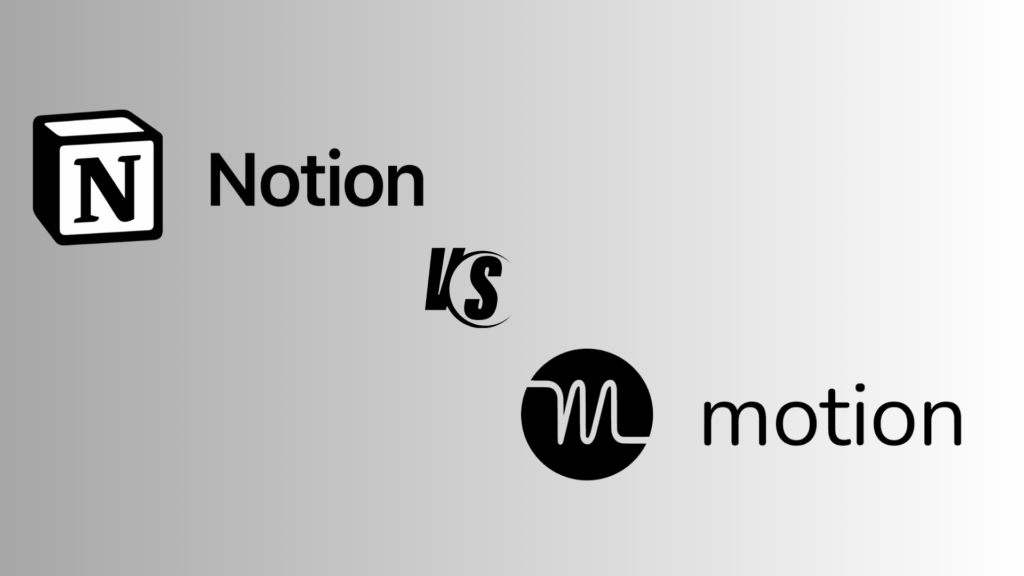

Pros:
Cons:
Pros:
Cons:
| Feature | Motion | Notion |
|---|---|---|
| Core Focus | AI task management & scheduling | Knowledge management & collaboration |
| Automation | AI-driven task prioritization & scheduling | Manual setup, basic automation via integrations |
| Time Management | AI-based time blocking, calendar sync | Manual scheduling |
| Customization | Limited customization options | Highly customizable with templates & databases |
| Collaboration | Basic team features, individual focus | Advanced real-time collaboration & permissions |
| Project Management | Automated scheduling & task prioritization | Custom workflows with Kanban, tables, timelines |
| AI Functionality | Task prioritization, dynamic scheduling | Idea generation, content organization |
| Calendar Integration | Full calendar sync, proactive scheduling | No native sync, requires third-party tools |
| Pricing | Starts at $19/month, no free plan | Free plan available, paid plans from $10/month |
| Best For | Automated task management & scheduling | Customizable workspaces, knowledge management |
Motion and Notion have a different mindset when it comes to project management.
Motion’s project management model is highly automated. The app connects directly to your calendar, orders tasks based on deadlines and priority, and provides suggested blocks of time for each task.
This is extremely useful for the working professional who wants an app that not only schedules your tasks but actually works them into your day.
For example, if you’re working on several projects, Motion will schedule your time slots for each task according to priority and time available, so you can cross off things on your list without having to manage them manually.
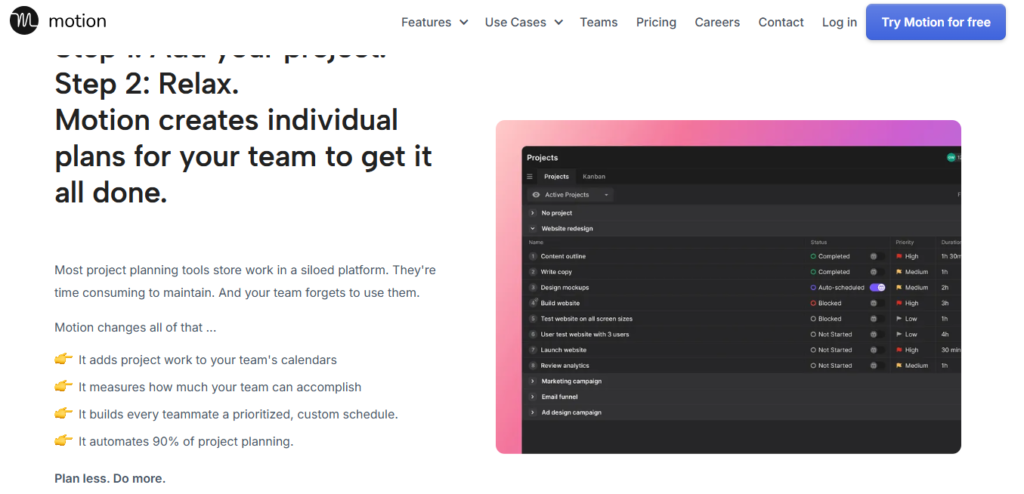

For a small team, Motion is a better choice as a project management tool.
In contrast, Notion, as a project management tool, is like building your own project management features from scratch.
Notion does provide a strong set of resources for keeping track of tasks and deadlines. Kanban boards, task databases, and timelines can be used to create a full picture of any project.
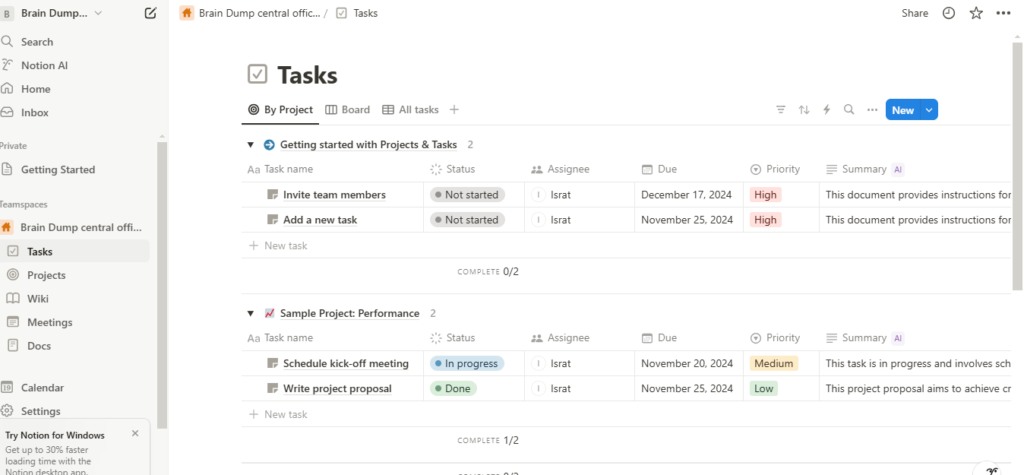

Such customization is excellent for teams that want to have freedom in how their projects are laid out.
Yet, the absence of automation means that users have to manually update their schedules and priority tasks, which can become cumbersome over time.
If you want an AI-driven project manager, Motion is probably the app for you.
If you’re interested in having more control over where things are placed and are willing to do the manual work, Notion offers much more flexibility. But keep in mind that it might get overwhelming.
Winner: Motion
This is where Notion really excels when it comes to notes and knowledge management.
With Notion, you can create a unified knowledge base that can contain anything from meeting notes to project documentation, brainstorming, and planning.
Its strong database functionality lets you tag and categorize notes so that all your notes can be searchable and organized.
The fact that the content can be presented in table, list, or board format makes it adaptable for managing both personal and team knowledge.
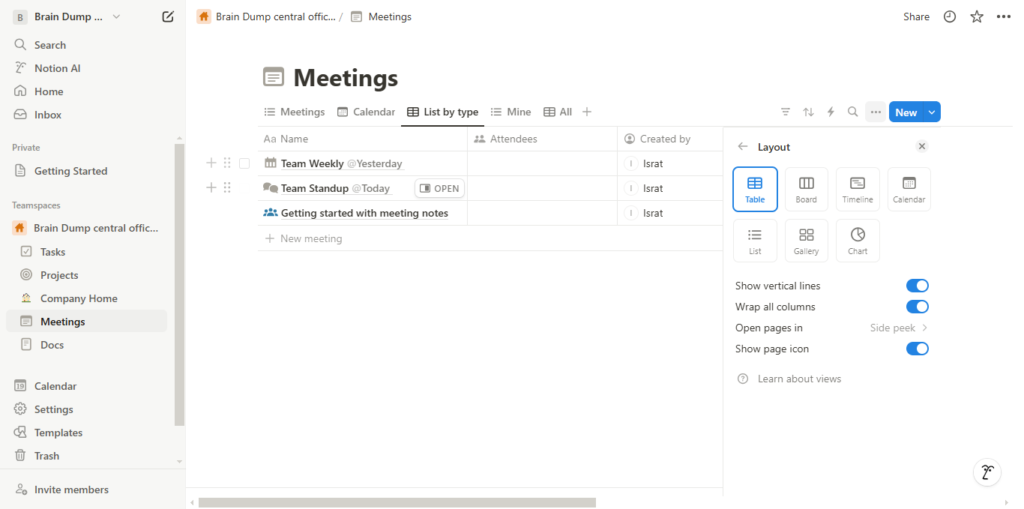

Motion provides basic note-taking features but is much more geared toward tasks and scheduling. You can set up tasks and add notes, but it’s not as comprehensive when it comes to categorizing and storing massive amounts of data as Notion is.
If you want somewhere to store, organize, and retrieve vast quantities of notes, documents, and information, Notion is definitely the choice.
Winner: definitely Notion
Both tools support collaboration, and when managing teams, they each facilitate teamwork in a different way.
Motion is geared towards the single user, though some simple team features like assigning tasks and sharing projects exist.
Yet, it is best suited for individual or personal productivity and time management rather than collective work
It makes it easy to assign team members, manage them, and schedule joint tasks, but it lacks the features needed for teams of large size.
Notion, by contrast, thrives on co-working. It facilitates collaboration in real-time – multiple people working on the same document or page.
You can set up shared wikis, task boards, and databases that all of your team members can use and modify to ensure everyone is on the same page. Notion’s permissions framework is similarly incredibly robust and allows team admins to manage who can view, edit, and comment on documents.
Notion is much better if you have a large team and you have to work on content, share knowledge, and collaborate on projects together. However, for smaller teams or single users looking for a smart way to work on their own projects while staying in sync with teamwork, Motion can still do the trick.
Winner: Notion
The greatest advantage of both tools is that they can replace other tools and act as a unified workspace. But each platform, in different ways, does just that.
Motion offers the distinction of being a one-stop solution that incorporates tasks manager, smart scheduling assistant and workflow automation.
Because Motion syncs with your calendar and analyzes your to-do list, you aren’t wasting any time, and it’s an ideal solution for those who want their task list and calendar to fit together. This integration negates the use of third-party resources such as Google Calendar or an external task manager.
Notion, on the other hand, excels as a flexible workspace that combines note-taking, databases, and project management into one customizable platform.
It allows users to create detailed workflows, document ideas, and organize projects with unmatched flexibility. Ideal for those who prefer a highly personalized, structured approach.
Winner: Its a Tie
Motion really takes the lead when it comes to calendar integration. It’s designed to sync with your calendar, automatically scheduling your activities and marking off time for them.
This integration is essential for anyone who needs to squeeze every last minute out of their day without manually scheduling everything themselves. Motion works as an AI-driven scheduling app and is proactive, constantly resetting your schedule to accommodate shifting priorities and timelines.
Notion, on the other hand, offers basic calendar functionality through Google Calendar integration, allowing you to view events but lacking the proactive scheduling features of Motion.
If you need an in-built calendar system that syncs with your tasks and blocks, Motion is the way to go.
Both have incorporated AI into their platform, but their functionality is different. Motion is more of a Task management software with AI; in contrast, Notion is more of an AI-driven knowledge management tool.
Motion uses AI to manage task prioritization and scheduling. Algorithms determine how much work to do first and when it should be done next, which is really helpful for users who need a cognitive assistant to keep track of their days.
For example, if you miss a deadline or tasks are conflicting, Motion automatically shifts your schedule, providing suggestions on how to organize your day.
Notion doesn’t support task prioritization or scheduling via artificial intelligence.
Notion AI can give you ideas on creating, organizing, and managing content, from generating ideas to summarizing documents.
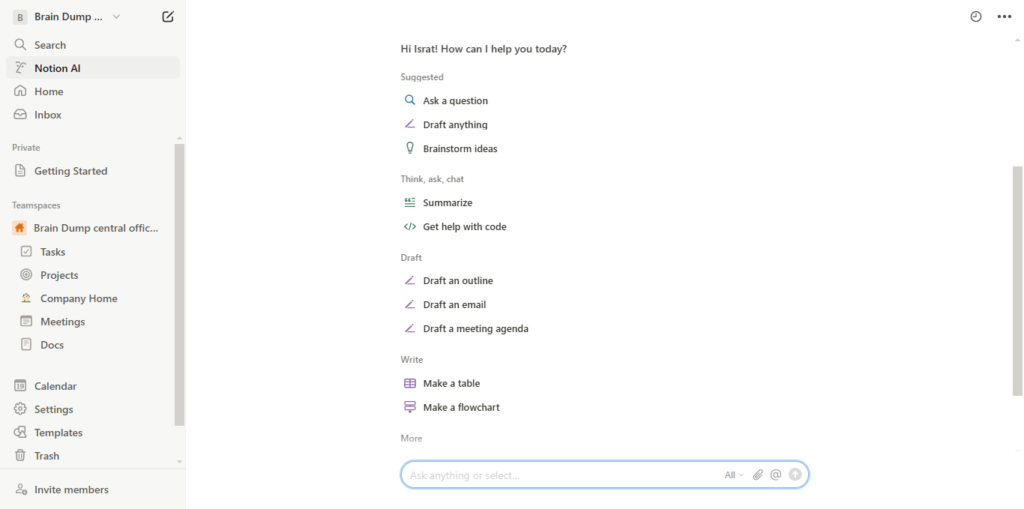

For example, You can ask the AI, “Can you suggest a project outline for a marketing campaign?” it’ll give you a project outline by leveraging relevant information stored in your Notion workspace. Or by pulling information from Slack and Google Drive.
While Notion AI is about getting personalized information from the Notion database, Motion AI is more of a personalized AI assistant for your Project Management.
Winner: Motion
Motion excels at time management with its AI-powered scheduling assistant. It automatically creates a time–blocked calendar for you, breaking your day into specific task slots.
While it doesn’t provide detailed manual time tracking (like a timer), it does track how you’re spending your time based on your task list and calendar, giving you insights into your work habits.
Notion, on the other hand, requires manual input for task scheduling and time management. You can create detailed task lists, calendars, and Kanban boards to manage your time.
However, you’ll need to input the information yourself, and it won’t automatically adjust if your schedule changes.
While Motion excels in time management features, it does not have an in-built time tracker. Notion also lacks built-in time-tracking features, but you can create custom databases or integrate third-party tools (like Toggl or Clockify) to track time manually or with an extension.
Motion can automate recurring tasks, ensuring that weekly or daily activities are consistently added to your calendar without extra input. It integrates with calendars and task management systems, helping to streamline workflows across different tools.
Notion’s workflow automation relies on manual configuration through templates, databases, and integrations with tools like Zapier or Integromat.
While it lacks built-in AI-driven automation, users can automate processes such as task syncing, reminders, and data transfers, providing flexibility for custom workflows but requiring setup and maintenance. If you want a fully automated task manager you can check out Taskade or ClickUP.
Winner: Motion
Motion’s pricing starts at $19 per month for individual users; if you run a team of less than 20 members, It has a Business Standard Plan, which starts at $12 per user per month.
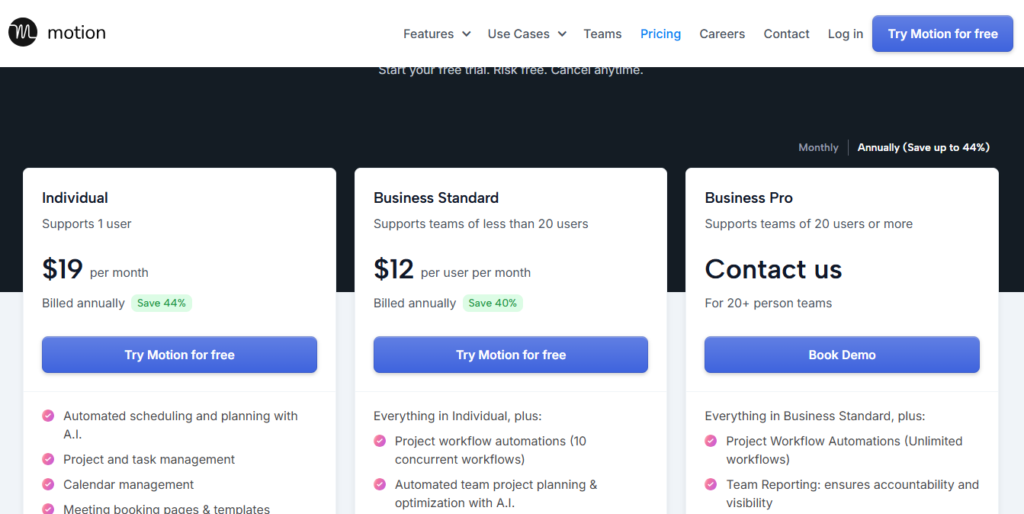

Notion Pricing: The best thing about Notion is that, with their Free plan, You get a lot of necessary features without many limitations. Their Plus Plan starts at $10 per seat/month, and their Business plan starts at $15 per seat/month.
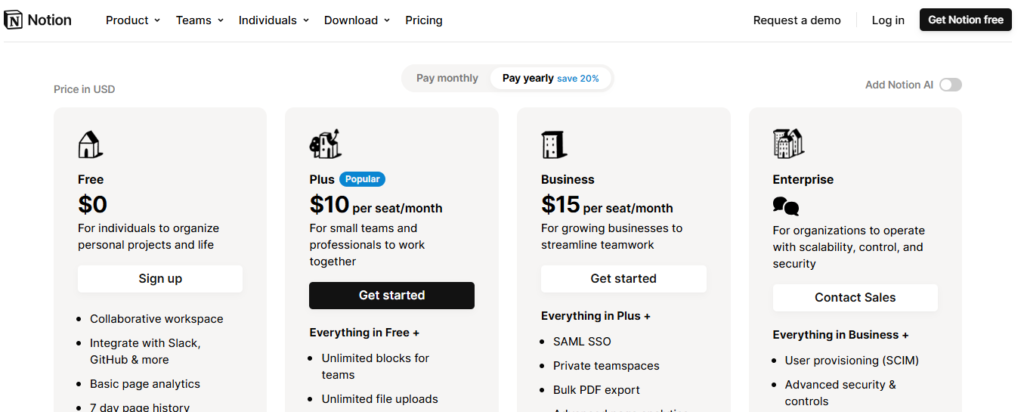

You have a choice between Motion and Notion, which will depend on your business requirements and the workflow model you are aiming to develop.
For anyone who needs a fully automated task manager that connects to your calendar and sets priorities for you, Motion is the way to go. It’s aimed at people who like things that are less interactive, so the software automates your time and tasks.
Otherwise, if you prefer to customize and want a custom, adaptive workspace for projects, knowledge, and collaboration, Notion is your best choice. Notion lets you customize your workflows from the ground up, and there’s no shortage of ways to take notes, manage databases, and collaborate with your team.
After all, they’re both very useful tools, and you need to choose between automation and customization.
No, Motion and Notion are not the same. Motion is dedicated to task automation, intelligent scheduling, and calendar sync, while Notion is a workspace with an interface for taking notes, managing projects, and storing knowledge.
For now, there is no direct in-built integration between Motion and Notion. However, both platforms are complemented by third-party integration frameworks such as Zapier or Integromat (Make). Such plugins let you sync data and automate between the two, but not natively.
Notion is popular because of its portability and customization. It brings note-taking, task management, and knowledgebases together. Its collaboration, large template collection, and ability to create customized workflows make it great for solo and small teams, not to mention a free trial.
Motion is a paid product because it provides AI-driven task management and auto-scheduling capabilities that need to be constantly updated and improved. There are also huge infrastructure costs associated with the integrations and intelligent workflows of the platform. Paid subscriptions rely on feature upgrades, keeping the platform up-to-date and functional.
Motion does not have a built-in Gantt chart. However, it does offer calendar integration and task prioritization functionality to aid in the planning and control of projects. If users specifically require Gantt charts, it may be better to use third-party tools such as Trello or Asana.
Motion provides a free trial that gives you the chance to check out the main functions. But once you finish your trial period, you’ll have to upgrade to a paid version for everything, including AI task scheduling, calendar integration, and task prioritization.
Motion integrates with Google Calendar, in fact. It syncs tasks to time slots on your calendar and prioritizes so you can efficiently divide your time. This feature underpins Motion’s focus on automated scheduling and bringing your work into alignment with your calendar time.
Helping you prioritize tasks and allocate time efficiently. This feature is key to Motion’s focus on automated scheduling and ensuring your tasks align with your calendar availability.